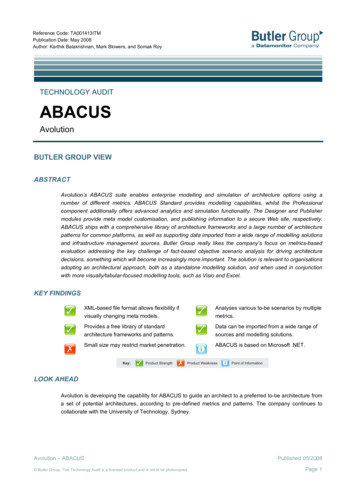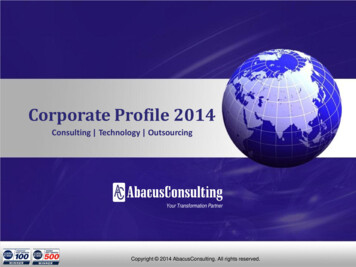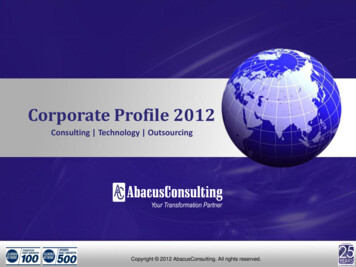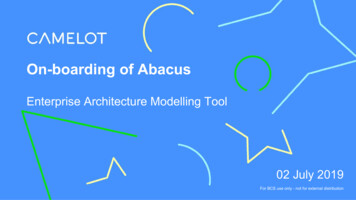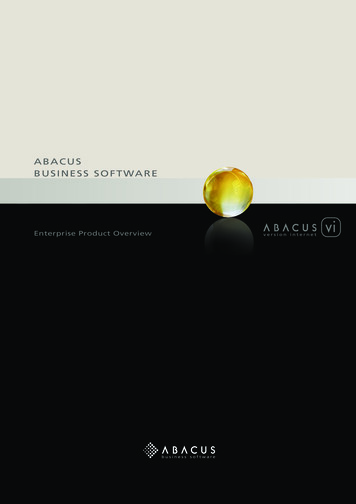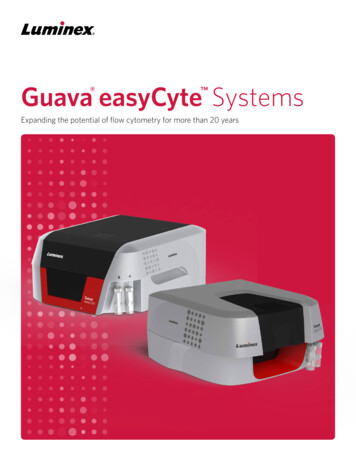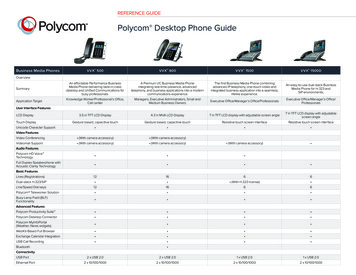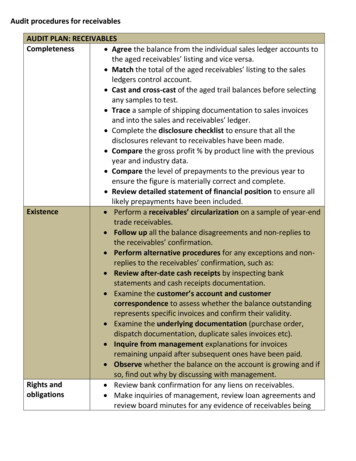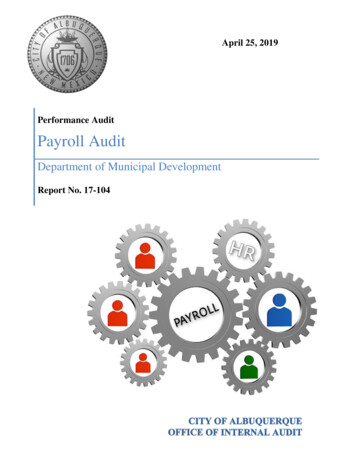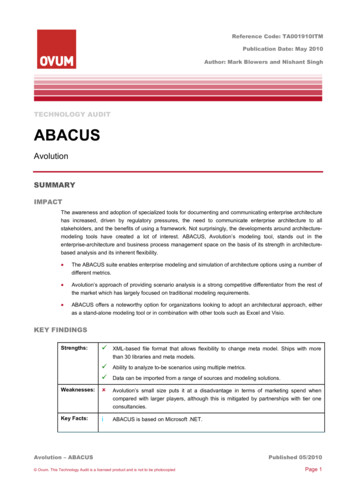
Transcription
Reference Code: TA001910ITMPublication Date: May 2010Author: Mark Blowers and Nishant SinghTECHNOLOGY AUDITABACUSAvolutionSUMMARYIMPACTThe awareness and adoption of specialized tools for documenting and communicating enterprise architecturehas increased, driven by regulatory pressures, the need to communicate enterprise architecture to allstakeholders, and the benefits of using a framework. Not surprisingly, the developments around architecturemodeling tools have created a lot of interest. ABACUS, Avolution’s modeling tool, stands out in theenterprise-architecture and business process management space on the basis of its strength in architecturebased analysis and its inherent flexibility. The ABACUS suite enables enterprise modeling and simulation of architecture options using a number ofdifferent metrics. Avolution’s approach of providing scenario analysis is a strong competitive differentiator from the rest ofthe market which has largely focused on traditional modeling requirements. ABACUS offers a noteworthy option for organizations looking to adopt an architectural approach, eitheras a stand-alone modeling tool or in combination with other tools such as Excel and Visio.KEY FINDINGS XML-based file format that allows flexibility to change meta model. Ships with morethan 30 libraries and meta models. Ability to analyze to-be scenarios using multiple metrics.Weaknesses: Avolution’s small size puts it at a disadvantage in terms of marketing spend whencompared with larger players, although this is mitigated by partnerships with tier oneconsultancies.Key Facts:iABACUS is based on Microsoft .NET.Strengths:Data can be imported from a range of sources and modeling solutions.Avolution – ABACUS Ovum. This Technology Audit is a licensed product and is not to be photocopiedPublished 05/2010Page 1
TECHNOLOGY AUDITOVUM VIEWEnterprise architecture as a discipline still lacks the data and performance analytics-driven approach that isbecoming pervasive in IT. Without a fact-based assessment of each architecture option, enterprisearchitecture is prone to be guided by opinion, which can prove expensive, open to manipulation, andinefficient. This is where a metrics-based tool such as ABACUS holds a distinct advantage.Avolution’s ABACUS suite enables enterprise modeling and simulation of architecture options using a numberof different metrics. ABACUS ships with a library of architecture frameworks and a large number ofarchitecture patterns for common platforms, as well as supporting data imported from a range of modelingsolutions and infrastructure-management sources. Ovum likes the company’s focus on metrics-basedevaluation that addresses the key challenge of fact-based objective scenario analysis for driving architecturedecisions, which is something that will become increasingly more important.Through ABACUS, Avolution has expanded the scope of enterprise modeling solutions by choosing toprovide scenario analysis that differentiates it from the traditional modeling market populated by establishedmodeling-tools vendors. Simulation and comparison do not appear to be a focus area for other modelingvendors, which are concentrating on developing standard reference architectures for governance,compliance, and best-practice initiatives. ABACUS includes these capabilities, but its focus on metric-basedevaluation of architecture options and scenarios is what makes it stand out. Ovum believes that Avolution’sapproach is innovative and will become more relevant with the increasing adoption of analytics by ITmanagement and the enterprise.Recommendations ABACUS is of particular interest to organizations where flexibility is an important requirement. ABACUS is a solution well aligned with the requirements not only of enterprise architecture, but also avariety of infrastructure initiatives and process-optimization projects. As a strong enterprise modeling solution, ABACUS offers value beyond enterprise architecture formedium-sized and large enterprises, software companies, and SIs.FUNCTIONALITYSOLUTION OVERVIEWAvolution supplies ABACUS Standard and Professional. The Professional products provide the full set ofarchitecture-modeling and scenario-analysis capability, and the Standard products offer mostly architecturemodeling functionality. The solution enables enterprise modeling based on the component, connection, andconstraints framework, with features for assigning properties for components and connections accessiblethrough a tabular view alongside the graphical models (see Figure 1).Avolution – ABACUS Ovum. This Technology Audit is a licensed product and is not to be photocopiedPublished 05/2010Page 2
TECHNOLOGY AUDITFigure 1:ABACUS overviewSource: AvolutionOVUMThe ABACUS Standard edition is the entry-level solution that offers comprehensive architecture-modelingfunctionality, some analytical capability, a common repository, and extensive data import and exportcapabilities. ABACUS Professional provides additional evaluation functionality, such as comparison ofarchitecture options by performance, TCO, reliability, and other metrics. The Enterprise Edition is acollaborative solution where users connect to the enterprise server to synchronize their local copy with theserver repository, resolving conflicts if they occur. This minimizes network traffic and allows organizations toavoid physical or performance limitations on the number of user clients that can work collaboratively.The ABACUS Designer ships as an add-on to the Professional and Standard editions and enables thecreation of meta models based on pre-defined ABACUS libraries or entirely new frameworks. The ABACUSPublisher, which is also shipped as an add-on to both editions, allows publishing of 2D and 3D models alongwith metrics to a secure web site to provide a customizable environment where if required only specificportions of models can be made available. Avolution also offers the Data Entry option, which is the strippeddown version, to allow use of the basic forms and grids in a CMDB/operational deployment.The ABACUS solution is focused on three key aspects. First is the flexibility of meta model creation, includingeasy import from existing models, especially those built on Visio and Excel. Second is the simulation ofarchitecture options, enabled partly by the capability to quickly create multiple scenarios through architectureand attribute property modification. And third is the integration with a range of infrastructure data sources.Avolution – ABACUS Ovum. This Technology Audit is a licensed product and is not to be photocopiedPublished 05/2010Page 3
TECHNOLOGY AUDITSOLUTION ANALYSISEase of UseABACUS Standard allows users to access the traditional scope of enterprise modeling (documentation,communication, collaboration, and monitoring). The ABACUS solution provides a set of key features such asmodel querying, model check-in/check-out, and policy-based notification in the event of a repository ruleviolation. Users can set their own rule/constraint definition, and can progressively delineate their definitionsand enforcement.ABACUS has a rich iconography that can be used to build components and create 3D models. ABACUS’sability to create 3D models is a unique feature that allows users to view models at a much higher level ofdetail than that of a 2D view. Ovum is impressed with the visual richness of the 2D and 3D models, includingthe component and connector iconography and the intuitiveness of the charts and graphs.Tool ArchitectureAn ABACUS file comprises meta models and multiple architectures, along with views for each architecture.The solution provides a large set of libraries comprising standard frameworks such as The Open GroupArchitecture Framework (TOGAF), ArchiMate, and PeaF, as well as common architecture patterns.At the heart of ABACUS is an XML-based file format (tree-based hierarchical file storage structure) that actsas an objects database. A new component or connection (the building blocks of ABACUS architecturemodels) is saved as another object in the objects database. This is significant because creation of newarchitecture meta models or enhancements to existing meta models can be implemented using simple “rightclicks” in the standard user interface, as opposed to making changes to the internal database that manymodeling tools need to do. The changing of meta models solely by updating the internal database typicallyleads to long implementation times for customizing meta model frameworks, which again remain rigid andoffer limited scope for expansion or enhancements.The ABACUS approach to defining meta models uses three key units: component, connection, andconstraints; a structure that conforms to the IEEE1471 standard (Avolution’s founders were contributors to theIEEE standard). ABACUS ships with various libraries of such components, connectors, and constraints.There are more than 30 libraries or meta models, including TOGAF 8.1, 2008 and 9, Zachman, CapgeminiIAF, PeaF, ArchiMate, BMM, BPMN, and DoDAF/MoDAF. The list of libraries includes over 50 commonarchitectural patterns. The flexibility of the Avolution approach provides a much larger number of standardarchitectural frameworks compared to other modeling solution providers. The solution permits users to createnew libraries or merge existing libraries to create an organization-specific framework in minutes.AdministrationTo ensure integrity in a distributed repository environment, ABACUS makes use of the concurrent versioningsystem (CVS) approach (Subversion). The ABACUS server is built on top of a freely available CVS and canbe deployed either centrally or distributed with synchronization between distributed servers that are managedautomatically by the solution.Avolution – ABACUS Ovum. This Technology Audit is a licensed product and is not to be photocopiedPublished 05/2010Page 4
TECHNOLOGY AUDITFor managing system-user rights, ABACUS Administrator allows the management of a complete set of usersand user groups with full CRUD (Create-Read-Update-Delete) permissions all the way to individual attributelevel. Permissions are defined at the role or group level, as opposed to the individual user level, so that whilemembership of the groups may change, permissions remain fixed. For specific user permissions, a groupneeds to be created with a user as the sole member. To simplify administration, a graphical UI is includedwith ABACUS Administrator that allows the management of users, the membership of user groups, andpermissions. ABACUS also allows users and user groups to be imported from standard directory systemssuch as Microsoft Active Directory.Lifecycle SupportA typical usage scenario would involve the creation of architecture models either by modifying ABACUSlibraries, importing models from tools such as Visio and Excel, or from scratch, and creating multiplearchitecture scenarios by editing properties (the data can be imported from databases, spreadsheets, andservice-desk solutions) and components and connectors. The user would then run simulation models thatgenerate metrics on the parameters to be evaluated. Simulations around the TCO comparison work byassigning life-cycle costs to components in an architecture, while reliability evaluation uses Monte Carlosimulations with mean time to repair and mean time between failure of the components and connections.ABACUS also provides simulations around environmental metrics such as power, heat, and carbon footprint,which are becoming an increasingly important consideration for organizations.All components in the models can have properties such as behavior and cost attached to them and can beviewed in the context of the architectural models, allowing for a flexible solution. The properties provide thebase data for simulation capabilities to help users make fact-based decisions on architecture trade-offs,understand performance, reliability, and cost considerations of comparable architectures, and analyze theimpact of change. ABACUS’s data model allows enforcement/warning constraints around data types toensure high data quality.ABACUS Professional allows users to create many architectures in the same repository. This allows users toview as-is and to-be architecture(s) in the same model. Users can have more than two architectures, allowingtrue comparative analysis and not just the filtering or tagging of objects that most of the other tools do. Thesolution allows users to modify properties of the components to simulate the performance and cost impact ofthe changes. Simulations include a performance evaluation, which uses a discrete event simulator (DEVS)that assesses the flow of messages through the architecture across various components. Performancesimulation is based on layered queuing network models and activity cycle diagrams.VisualizationSimulation models that generate metrics are displayed through a set of charts and graphs. ABACUS providesthree primary charts for analysis: timelines, capability space charts, and trade-off diagrams. The timelinesoffer snapshot visualization to provide a collated view of historic events, and the capability space charts offeroptions analysis for tentative roadmaps. The trade-off diagrams rate architectural scenarios against multipleparameters and can include factors such as openness and security, in addition to performance, reliability, andTCO. The trade-off diagram allows easy visual determination of the evolution of architectures and allowsusers a high degree of flexibility in prioritizing decision parameters.Avolution – ABACUS Ovum. This Technology Audit is a licensed product and is not to be photocopiedPublished 05/2010Page 5
TECHNOLOGY AUDIT2D views can be exported to standard image formats, SVG, and HTML, and 3D views are exported to VRMLor HTML. Reports are exported to HTML, PDF, Crystal Reports, Microsoft Word, and Microsoft Excel, withgraphs exported to BMP. The entire model can be exported/published to XML, Microsoft Access, or HTML.Figure 2:Trade-off analysisSource: AvolutionOVUMSOLUTION STRATEGYAvolution focuses on large enterprises that have more than 250 people and complex technologyinfrastructures with a combination of legacy systems and a strong pipeline of new developments. Avolution’starget markets include architecture practitioners in complex environments, SIs, consultancies,software/system development houses, and infrastructure providers. Avolution’s recent partnerships will alsoallow it to broaden its reach and move up the stack to target larger customers.Return on investment cannot be measured exactly and depends on benefits such as increased re-use ofexisting solutions/resources, reduced time for product transformations, and improved architecture-relateddecision making. Avolution claims that ABACUS practitioners have reported a reduction in process analysistime, an improvement of between 20% and 30% in the success rate of proposals, and have avoided additionalcosts by not making wrong decisions. The common meta-model approach can provide up to 20% in overallefficiency improvement across an organization.Avolution sells its products through a direct sales force, strategic partnerships with companies that influencecorporate IT decision-making, and channel partnerships with organizations that advise corporations on theirIT and business strategies.Avolution – ABACUS Ovum. This Technology Audit is a licensed product and is not to be photocopiedPublished 05/2010Page 6
TECHNOLOGY AUDITAvolution has business partnerships with Logica, BT Global Services, Capita, Arismore, Edarat, Resultex,and ArchAngel IT, as well as technology partnerships with Microsoft, The Open Group, and Pragmatic EA.The partnership with Logica in particular is noteworthy because ABACUS is Logica’s preferred global solutionfor enterprise architecture and SOA. Avolution is developing the capability for ABACUS to guide an architectto a preferred to-be architecture from a set of potential architectures, according to pre-defined metrics andpatterns. The company continues to collaborate with the University of Technology, Sydney.Ovum believes the Avolution metrics-based approach will become increasingly pertinent and there is a strongpossibility that a large vendor will enter this space in the next three years. Avolution’s continued relevance istherefore contingent upon expanding its direct sales and channel partnerships, something that might provedifficult because of the small size of the company. Although this is mitigated by partnerships with tier oneconsultancies. In addition, the company needs to build closer relationships with other ISVs in areas such asbusiness intelligence, software development, and systems management.ABACUS can be supplied as an integrated suite or as individual component modules. Licenses need to bepurchased upfront and there is an optional annual 20% maintenance fee for general maintenance. Theaverage project value over the first year is 100,000 with services comprising 40% of the cost, with theaverage cost for the following three years at 40,000 per annum (primarily maintenance). Avolution typicallytargets a quarterly minor and an annual major release strategy for its products, with beta releases availableone to two months prior to this for refinement purposes.IMPLEMENTATIONAccording to Avolution the deployment effort for ABACUS is minimal for basic implementation whereorganizations can easily download and install ABACUS. Implementation takes about an hour, and there areno significant business procedures that need to be changed because ABACUS integrates with many standardbusiness methods, processes, and frameworks.The company has partnerships with several SIs for value-added services, but usually not much expertise isrequired for installation. Unlike a lot of focused modeling solutions, ABACUS is aimed at enabling theindividual architect to quickly define architecture models and perform trade-off simulations. Thereforeinstallation does not have to involve the usual model-building phase. ABACUS can be deployed using amodular approach and organizations can implement ABACUS Standard as the base product and deploy theother suite products (ABACUS Professional, ABACUS Designer, ABACUS Administrator and ABACUSPublisher) as add-ons.Avolution’s typical deployment involves between three and five seats for the architecture team, in addition fiveto 10 business analyst seats for BPM and about 10 data-entry seats. ABACUS clients are Windows .NETapplications, which run on Microsoft Windows 2000, Windows XP SP2, or later platforms, and the ABACUSserver requires the Subversion platform which is available for Red Hat 8.0 and 9, SPARC/Solaris 2.5–10, MacOS X, Windows NT, 2000, XP and 2003, HP UX, AIC, and IBM i5/OS. ABACUS Standard requires MicrosoftOffice 2003 or higher version for Visio and Excel import/export features. The ABACUS Publisher also runs onthese platforms as well as accommodating Linux and Mac OS. The Publisher client requires Firefox 1.5, orhigher, or Microsoft Internet Explorer 6, or higher, and the SVG and VRML Viewers, which are freelyavailable.Avolution – ABACUS Ovum. This Technology Audit is a licensed product and is not to be photocopiedPublished 05/2010Page 7
TECHNOLOGY AUDITThe company offers half and full-day training courses either on site or at the nearest Avolution office, inaddition to self-guided computer-based learning courses. Avolution hosts an online community that containstutorials, case studies, libraries, and user forums for assistance. Product support is based on the type ofcontract selected by organizations, which can be general, gold, or platinum maintenance. The generalcategory provides only minor upgrades of ABACUS (unlimited) with 24x7 hour email support. The gold andplatinum cover offer unlimited major and minor upgrades with 24x7 hour email support, nine-hour-per-dayphone support, and extra hours of on-site support at a discounted rate depending on the license sc
ABACUS is a solution well aligned with the requirements not only of enterprise architecture, but also a variety of infrastructure initiatives and process-optimization projects. As a strong enterprise modeling solutio
